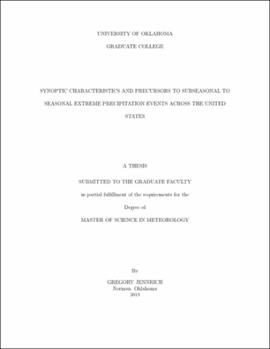| dc.description.abstract | In the United States and throughout the world, extreme precipitation events are a major cause of loss in life, property, and economic progress. Although the science of hydrometeorology has made significant improvements to the prediction and understanding of these events in recent decades, there is still much to learn about these events in the subseasonal to seasonal (S2S) timescale. This thesis focuses on identifying synoptic patterns and possible precursors ahead of an extreme precipitation event over the contiguous United States (CONUS). First, we provide a robust definition for 14-day and 30-day ``extreme precipitation events," based on running precipitation totals from Parameter Elevation Regression on Independent Slopes Model (PRISM) daily precipitation data. Criteria for the events include exceedance of percentile thresholds, spatial extent, and the distribution of rainfall over the event period. The CONUS is partitioned into different geographic regions in order to compare and contrast the synoptic patterns associated with events in different parts of the country. Using these identified events, atmospheric variables from reanalysis (e.g., geopotential height, zonal winds, and integrated vapor transport) are composited to understand the evolution of the atmospheric state before and during a sub-seasonal extreme precipitation event. Common synoptic signals seen during events include significant trough-ridge patterns, an energized subtropical jet stream, and enhanced integrated vapor transport into the area. Also, atmospheric river activity increases in the region during extreme events. Identified signals are similar for both 14-day and 30-day events, albeit with weaker composite anomalies for 30-day events. Further, the increases in frequency of atmospheric river activity is greater west of the Rockies, with respect to other regions, for 30-day events as compared to 14-day events. Modes of climate variability and lagged composites are investigated for their connection to 14-day extreme precipitation events and their potential use in lead time prediction. Key findings include synoptic anomalies in the North Pacific and regional connections to modes such as the Pacific North American (PNA) pattern and the North Pacific Oscillation (NPO). Regional differences in these characteristics and possible reasons for them are discussed. Taken together, these results represent a step forward in helping forecasters to understand and identify sub-seasonal events in order to mitigate loss due to extreme precipitation events. | en_US |
